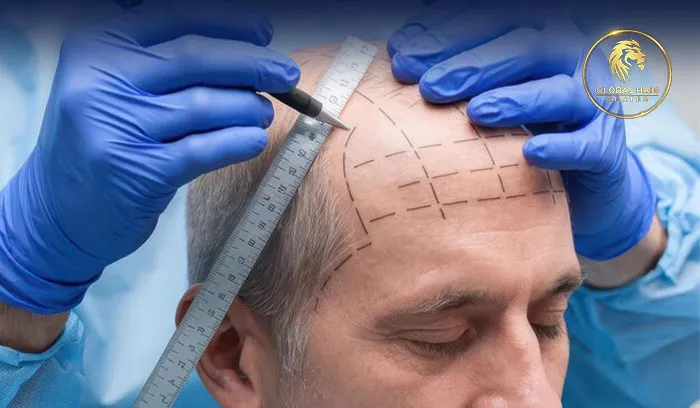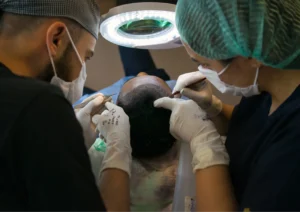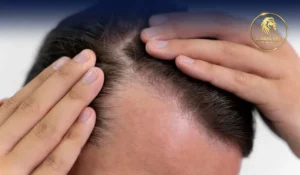The Journey to Natural Hair: Understanding the FUE Hair Transplant Process

The Journey to Natural Hair: Understanding the FUE Hair Transplant Process
In the world of hair restoration, the follicular unit extraction (FUE) technique has emerged as a revolutionary method, offering natural-looking results and renewed confidence to individuals experiencing hair loss.
Understanding the FUE hair transplant process can help individuals make informed decisions about their hair restoration journey. This comprehensive guide shares the stages, benefits, and considerations of FUE hair transplantation, providing valuable insights for those considering this transformative procedure.
FUE Hair Transplantation
FUE hair transplantation involves the extraction of individual hair follicles from a donor area, typically the back or sides of the scalp, and their transplantation into balding or thinning areas. Unlike traditional strip harvesting methods, FUE does not require the removal of a linear strip of scalp tissue, minimizing scarring and allowing for quicker recovery times. This technique has many uses such as beard hair transplant and eyebrow hair transplant.
Pre-Procedure Preparation
The journey to natural hair begins with a thorough consultation with a skilled hair transplant doctor. During this initial meeting, the doctor evaluates the patient’s hair loss pattern, scalp condition, medical history, lifestyle factors, and expectations.
The pre-procedure consultation is a vital step that sets the foundation for a successful FUE hair transplant journey.
This personalized assessment helps determine how the process will go and allows the doctor to design a customized treatment plan tailored to the individual’s unique needs.
The FUE Procedure
On the day of the procedure, the patient arrives at the clinic prepared for the FUE journey. Local anesthesia is used to ensure comfort during the procedure. The doctor then utilizes specialized tools to carefully extract individual follicular units from the donor area. The precision and expertise of the surgical team play a crucial role in ensuring minimal damage to surrounding tissues and optimal graft quality.
Once the needed number of hair follicles is harvested, the focus shifts to the recipient area. The doctor designs the new hairline and strategically places the extracted follicles with the exact angle and direction to mimic natural hair growth patterns and density. This ensures seamless, undetectable results that blend harmoniously with existing hair.
Artistry of Graft Placement
The artistry involved in graft placement extends beyond technical proficiency, it includes an understanding of facial harmony, hairline design principles, and patient-specific aesthetic goals. Doctors skilled in FUE transplantation know how to place grafts at varying angles and densities to mimic natural hair growth, ensuring a seamless transition between transplanted and existing hair. Factors such as hair curvature, color, and texture are also considered during this meticulous process, further enhancing the overall naturalness of the results.
Recovery Phase
Following the procedure, patients receive detailed post-operative instructions and guidance for optimal recovery. While some initial swelling and discomfort are common, these symptoms subside within a few days. Patients are advised to avoid strenuous activities and follow a prescribed medication regimen to aid healing and minimize any potential complications and discomfort.
The Growth Journey
Patience is key as the transplanted hair undergoes a natural growth cycle. Within the first few weeks, the transplanted follicles shed as part of the normal hair growth process. This temporary shedding phase is followed by new hair growth. Patients typically start noticing visible hair growth within a few months, with full results becoming apparent after about 12 months.
Benefits of FUE Hair Transplantation
The advantages of FUE hair transplantation are many which makes it increasingly popular among individuals seeking hair restoration solutions. These benefits include:
- Natural-Looking Results
FUE delivers natural-looking hairlines and density that seamlessly blend with existing hair for undetectable outcomes. - Minimally Invasive
The safe nature of the procedure ensures faster healing and less post-operative discomfort compared to traditional methods. - Customized Treatment
Each FUE procedure is tailored to the patient’s unique hair loss pattern, hair characteristics, and aesthetic preferences, to result in complete satisfaction. - Permanent Solution
Transplanted hair is permanent and continues to grow naturally, eliminating the need for ongoing maintenance or touch-up procedures. - Versatility
FUE can address various areas of hair loss, including the scalp, eyebrows, beard, and even eyelashes, catering to diverse patient needs. - Boosted Confidence
Restoring your thick, full hair not only enhances physical appearance but also boosts self-esteem and confidence levels, positively impacting overall well-being.
Considerations and Expectations
While FUE hair transplantation offers remarkable benefits, it is essential for individuals to have realistic expectations and understand the limitations of the procedure. Factors such as existing hair quality, donor hair availability, scalp laxity, and medical history can influence the outcome.
Open communication with the hair transplant team and adherence to post-operative care guidelines are essential for optimal results.
Exploring Advanced Techniques and Tools
Modern FUE techniques continue to evolve, including advanced tools and technologies to further improve transplant outcomes.
Robotic-assisted FUE systems, for example, offer amazing precision in graft extraction and placement, reducing human error and optimizing graft survival rates.
Additionally, the use of high-powered microscopes allows doctors to assess each follicle at a microscopic level, ensuring the selection of the best follicular units for transplantation.
These technological advancements contribute to enhanced efficiency and improved patient satisfaction.
Emphasizing Long-Term Care and Maintenance
While FUE hair transplantation provides permanent results in terms of transplanted hair growth, ongoing hair care and maintenance play a significant role in preserving overall hair health. Post-transplant care instructions typically include gentle hair-washing techniques, avoidance of harsh chemicals or styling products, and adherence to prescribed medications to support healing and minimize inflammation.
Regular follow-ups with the transplant team allow them to monitor progress, address any concerns, and guide long-term hair care strategies tailored to individual needs.
Addressing Common Concerns
There are some common concerns that patients are worried about. Usually, these concerns are addressed in the consultation session. These concerns can include knowing the role of genetics in hair loss patterns, explaining the differences between male and female hair transplantation considerations, and providing insights into recovery timelines based on individual factors.
Conclusion
The journey to natural hair through FUE hair transplantation is an effective and long-lasting solution to hair loss. Knowing how the FUE process goes and its benefits can help patients decide what to do. This guide aims to help individuals start their hair restoration journey with confidence, paving the way for renewed self-assurance and vibrant, natural-looking hair.

Perfectly Arched: The Ultimate Guide to.
Dubai, a city synonymous with luxury and innovation, has become a global hotspot for cosmetic procedures, including eyebrow transplants tailored.
Read More
Eyebrow Hair Transplant in Dubai: The.
In today’s beauty-driven world, eyebrows play a crucial role in defining the face and enhancing overall attractiveness. For many, thin.
Read More

